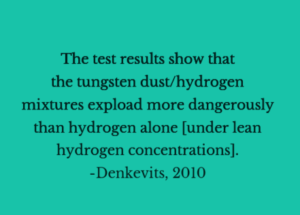1-Sentence-Summary: Nitrogen gas dilution can reduce the enhanced explosion effects of tungsten/hydrogen mixtures and can render the mixture inexplosible at low enough oxygen content.
Authors: A. Denkevits
Read in: Three Minutes
Favourite quote from the paper:

The author of this work performs explosion testing in a 20-L chamber. Explosion severity of hydrogen/tungsten hybrid mixtures is explored along with inerting effects of nitrogen dilution. The tungsten dust has a mean diameter of 0.5 µm and a weak electrical spark is used for ignition. The German explosion testing standard (VDI-Richtlinien) is followed and a 60 ms delay time is used.
The author reports maximum pressure and maximum pressure rise for tungsten/hydrogen mixtures. The dust concentration is varied from 0 to 6000 g/m3 and the gas concentration is varied from 7 to 18 % by volume.
The author also reports the effect of nitrogen dilution at 2000 g/m3 which is close to the worst-case dust concentration. From these results a limiting oxygen concentration is extrapolated. Mass spectroscopy of the combustion products is completed to determine the amount of oxygen left in the mixture after combustion.
Three of the main findings from this paper are:
- Hybrid mixtures of tungsten/hybrid explode more violently than the hydrogen alone at lean concentrations.
- Nitrogen gas dilution has a larger effect on pressure rise rate than maximum pressure.
- An extrapolated limiting oxygen concentration of 6-9% is found, although the bottom end is believed to be over conservative for specific applications.
The following sections outline the main findings in more detail. The interested reader is encouraged to view the complete article at the link provided below.
Finding #1: Hybrid explosions of tungsten/hydrogen mixtures are more violent then hydrogen alone
In a previous study the current author found that hydrogen gas mixed with a low-reactivity graphite dust reacted in one of three processes (Denkevits, 2007):
- At low hydrogen concentrations the graphite dust did not react at all.
- At medium hydrogen concentrations the graphite dust reacted much slower than the gas and a two-step explosion process was seen.
- At high hydrogen concentrations the graphite dust reacted on a similar timescale to the gas and a single-step or coupled explosion process was seen.
In the current study the tungsten dust always reacted in a single-step, coupled mechanism. Maximum pressure and maximum rate of pressure rise for the hybrid mixture were always larger than hydrogen alone at the same fuel-lean concentrations.
The maximum rate of pressure rise increased more than the maximum pressure from the addition hydrogen gas to the tungsten dust. Moving from 7% to 18% hydrogen by volume, maximum pressure increased by 150% and maximum rate of pressure rise by 450%. The hybrid effect also had a larger impact on lower dust concentrations. Concentrations as low as 100 g/m3 (four times lower than than the dust minimal explosive concentration alone) could be made to explode quite violently with hydrogen addition.
Finding #2: Nitrogen dilution reduced maximum rate of pressure rise more than maximum pressure
Explosion tests with increased nitrogen showed that the inerting effects had a larger impact on maximum rate of pressure rise then on maximum pressure. Dilution to 10% oxygen resulted in 1.3-1.6 times reduction in maximum pressure and 4-8 times reduction in maximum rate of pressure rise. The explosion tests also demonstrated a larger inerting impact at higher gas concentrations. At lower gas concentrations the inerting effect was much stronger on the hybrid mixtures than on the pure gas mixtures.
Finding #3: The extrapolated limiting oxygen concentration was found to be 6-9% for hybrid mixtures
The authors used maximum rate of pressure rise to estimate the hybrid mixture limiting oxygen concentration. For their application (thermonuclear industry) the maximum rate of pressure rise was chosen over maximum pressure, as it is an indication of the chance for fast-deflagration and the possibility of detonation.
To estimate the limiting oxygen concentration the authors plotted the maximum rate of pressure rise against the initial concentration of oxygen. The dust concentration was held constant (2000 g/m3) and the gas concentration was varied (7, 10, 14, and 18% by volume).
The results from their testing showed that maximum rate of pressure rise varied linearly with initial oxygen concentration, although the slope of the line depended on the amount of hydrogen. Extrapolating the different hybrid mixtures to zero rate of pressure rise gave limiting oxygen concentrations between 6-9% by volume. The authors suggest that 6% may be too conservative as the flames are likely to quench in larger geometries. They recommend 8-9% by volume to be a reasonable limiting oxygen concentration for tungsten/hydrogen accident scenarios in the nuclear industry.
My Personal Take-Aways From
“Hydrogen/Dust Explosion Hazard in ITER: Effect of Nitrogen Dilution on Explosion Behavior of Hydrogen/Tungsten Dust/Air”
This article gives very interesting data which is relevant to hybrid explosion research and practical hazard scenarios in the nuclear industry. From the research side, seeing that the tungsten combustion always interacts with the hydrogen reaction is in contrast to previous data with lower reactivity dust (Denkevits, 2007). This suggests that the flame temperature of the gas and the combustion steps of the dust are important in determining the hybrid explosion effects.
The data presented on inerting levels for tungsten/hybrid mixtures is useful to the nuclear industry. It would be interesting to compare the limiting oxygen concentration for hybrid mixtures to that of hydrogen alone, to see if both hazards are prevented at this level. Other articles by this author such as Denkevits and Dorofeev, 2006, Denkevits, 2007, and Denkevits and Hoess, 2015 are also of further interest to those working in this area.
Full Citation: [bibtex file=references.bib key=Denkevits2010]
[otw_shortcode_button href=”http://www.sciencedirect.com/science/article/pii/S0920379610000104″ size=”medium” icon_position=”left” shape=”square”]> > Get The Article[/otw_shortcode_button]
